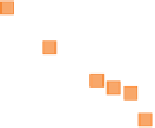Geology Reference
In-Depth Information
Cosmogenic radioisotope systems
2.0
TC 464
Regression lines
Linear
Exponential
MD
AESOPS
Radiocarbon dating
1. 5
The short-lived radioactive carbon isotope
14
C provides
an important dating tool in archaeology and Quaternary
geology. Terrestrial
14
C (half-life 5730 years) is formed by
the bombardment of
14
N nuclei in the atmosphere by
neutrons derived from cosmic rays (
14
C is the best
known example of a
cosmogenic
nuclide). The
14
C
atoms that are formed rapidly oxidize, becoming part of
the atmospheric inventory of CO
2
, and are incorporated
into plant tissue by photosynthesis. Living organisms
(plants and animals) maintain a carbon-isotope comp-
osition in equilibrium with atmospheric CO
2
during their
lifetime, but this steady state ceases when an organism
dies: the
14
C trapped in the dead organic matter decays
back to
14
N with time, providing an isotopic clock.
In
radiocarbon dating
, as this technique is called,
the minute amount of
14
C remaining in a sample
11
is
determined either by measuring its β
̃
activity, or by
counting the number of
14
C atoms individually using
an ultra-sensitive
accelerator mass spectrometer
. The
latter technique extends the range of radiocarbon dat-
ing back to at least 40,000 years. The age is calculated
using Equation 10.13:
Deep seawater
Zn isotope
composition
1. 0
0.5
0.0
0
5
10
15
20
25
30
Zn/Si (
μ
mol/mol)
Figure 10.15
Correlation between δ
66
Zn and Zn/Si in
cleaned siliceous marine diatom frustules (hard
parts) in core tops from the Southern Ocean TC464, MD
and AESOPS refer to drill cores sampled.
(
)
66
64
Zn
/
Zn
sample
δ
66
Zn
=
−
1
×
1000
‰
(
)
66
64
Zn
/
Zn
NIST
683
where NIST683 is the isotopic standard used. The Zn/Si
ratio is given in μmoles Zn per mole Si (= molar ppm).
(Source: Andersen
et al.
(2010), reproduced with
permission of Elsevier.)
(
)
14
12
CC
CC
/
varies in marine diatom skeletal material as a function
of Zn availability in the surface waters from which the
diatoms grow (represented here by Zn/Si ratios in dia-
tom frustules). Zn is a
micronutrient
which, when in
short supply, limits biological productivity. Owing to
its take-up by phytoplankton in the photic zone, the
element Zn is depleted to varying degrees in surface
seawater relative to deep ocean water. Phytoplankton
selectively incorporate the lighter isotope
64
Zn into
their tissues, leaving the remaining dissolved Zn
enriched in
66
Zn. Increased phytoplankton productiv-
ity leads to greater depletion of dissolved Zn (reflected
by lower Zn/Si in skeletal material) and depletion in
64
Zn relative to
66
Zn, resulting in higher δ
66
Zn in surface
seawater. Diatom skeletal parts grown from
Zn-depleted, high δ
66
Zn surface waters reflect this cor-
relation (Figure 10.15).
The isotopic compositions of Fe, Cu and Mo also
find palaeo-oceanographic applications, providing
information on oxygenation and metal cycling in
ancient oceans (Anbar and Rouxel, 2007).
1
0
(10.13)
t
=
ln
(
)
λ
C
14
/
12
sample
where
t
represents the age of the carbon sample in years,
λ
C
is the decay constant for
14
C in year
-1
(see exercise
10.3),
14
C/
12
C represents the atomic ratio of
14
C to
12
C in
the sample (or the
14
C count rate per gram), and (
14
C/
12
C)
0
represents the corresponding ratio or count rate at the
time the artefact or rock formed (we can approximate
this by using the value for present-day carbon).
From a geological perspective, the radiocarbon
method dates younger events (hundreds of years to
tens of thousands of years ago) than Ar − Ar and Rb − Sr
dating methods can routinely measure. It can only be
applied to artefacts or rocks that incorporate carbon of
biological origin.
Another cosmogenic isotope of geological interest is
beryllium-10 (
10
Be), which has a half-life of 1.39 Ma. It is
11
The proportion of
14
C to
12
C is typically of the order of 1 part
in 10
12
.
































































































Search WWH ::

Custom Search